Antitrust Policy Quiz 2
1/51
There's no tags or description
Looks like no tags are added yet.
Name | Mastery | Learn | Test | Matching | Spaced |
|---|
No study sessions yet.
52 Terms
Collusion
working together secretly to negotiate prices and quantities
Bertrand Duopoly (also known as Nash-in prices)
Assumes-two sellers, selling the exact same thing, setting prices simultaneously-buyers purchasr lowest price item. Sellers splot market in half
It’s a game-goal is to find an equilibrium
Nash Equilibrium
No player can unilaterally change its strategy in a way that improves its payoff
Strategy
a complete set of directions for how the player should play
Action
a particular move taken by a player
Best response
Player’s best strategy in response ot other possible strategies from other players
Profits
Seller 1’s best response to seller 2’s price is to set a slightly lower price, Seller 2 would respond the same way-this would lead them to cutting down to their marginal costs

Graph where you cut down to MC (Nash Equalibrium)
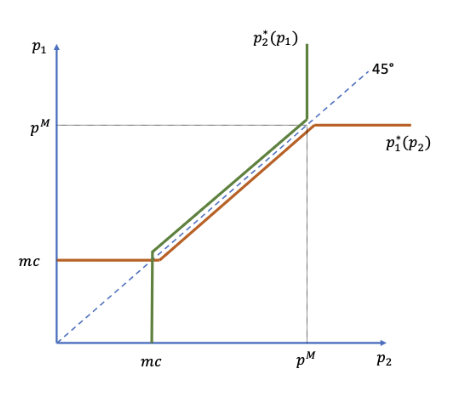
Bertrand Paradox
If you add a second seller to a market, and they play the Bertrand pricing game, price changes from the monopoly price to marginal cost. Adding more sellers doesn’t matter.
Not necessarily realistic but does suggest that sellers should consider what price their rivals will charge
Unrealistic aspects of Bertrand Model
1) Product differentiation-if products are even slightly different, lowest price would automatically win
2) Dynamic competition-If Seller 1 wins today, shouldn’t 2 undercut tomorrow
3) Full'/limited information-seelers don’t know each other’s cost all the time
4) Capacity-what if winning seller can’t serve all demand (airline)
Limited capacity
Can help to reach nash equilibrium
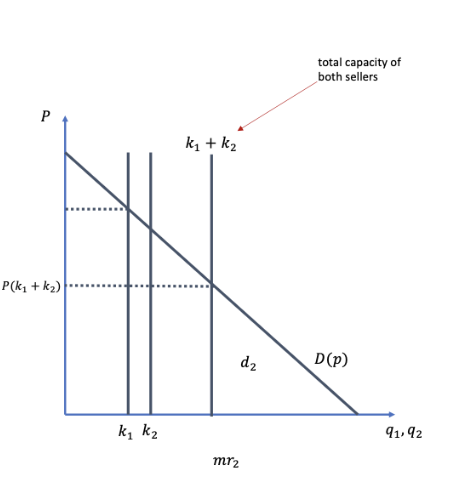
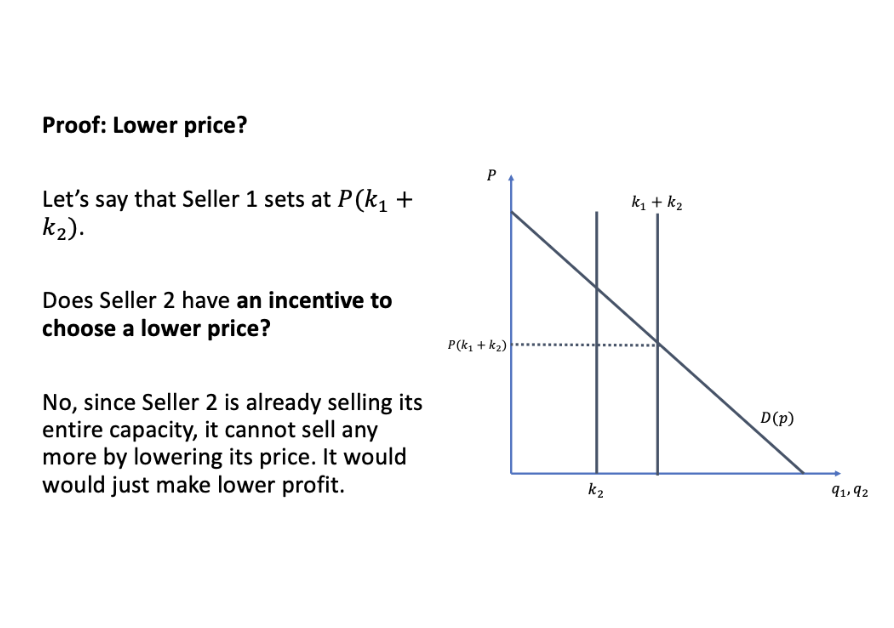
Not raising/lower price in this limited capacity situation
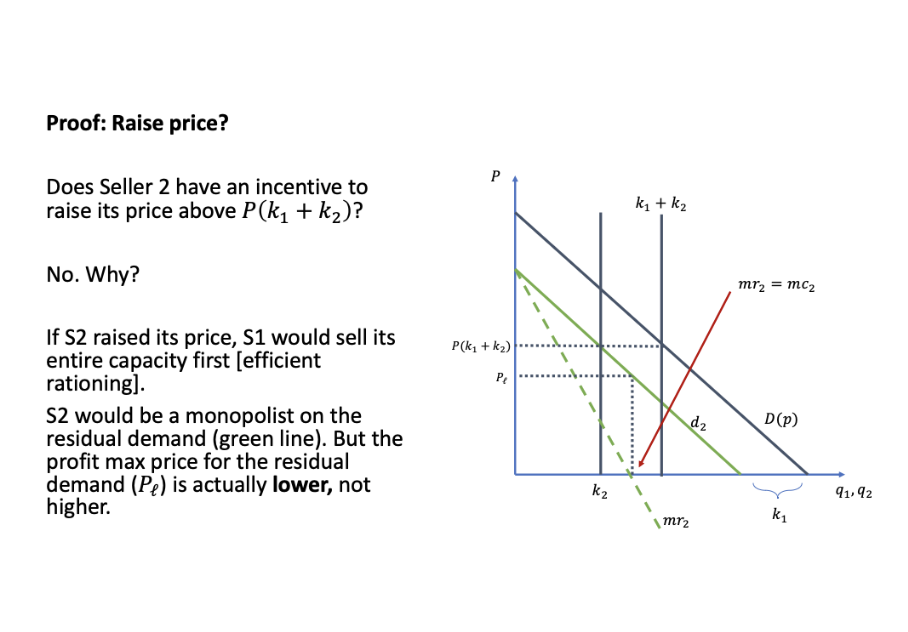
Cournot
Model with quantity (Bertrand uses prices)
Now known as Nash in quantities
Assumptions:
• Two sellers, selling the same exact product.
• Simultaneously decide quantity produced.
• Market price received by both firms is a function of total quantity
supplied: 𝑃 = 𝑃 𝑞! + 𝑞" = 𝑃(𝑄).
• Equilibrium is a pair of quantities where neither seller finds it
profitable to deviate.
* Quantity competition is isomorphic to a 2-stage game of capacity-
then-price competition.
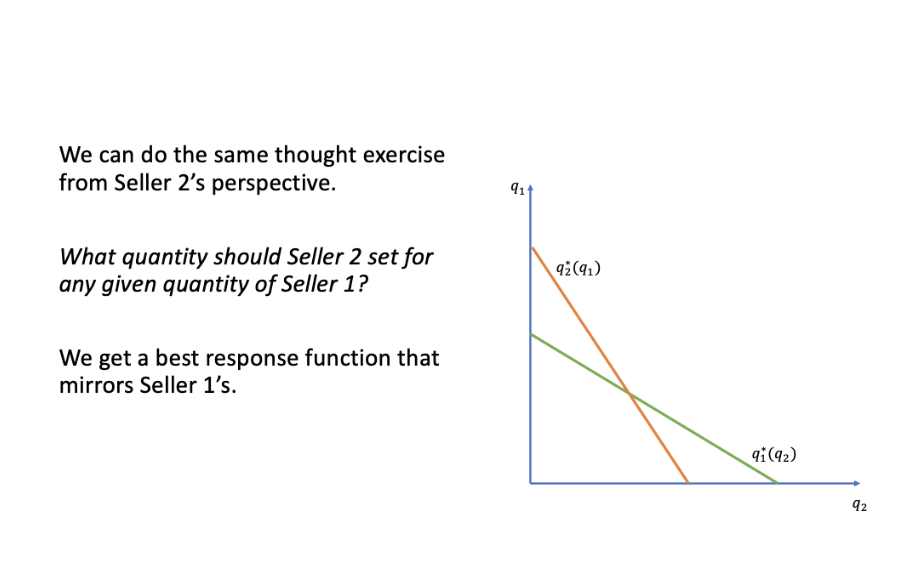
Nash Equilibrium
a mutally consistent combination of actions and conjectures, such that neither seller finds it profitable to deviate
Comparing bertrand, cournot, and monopoly
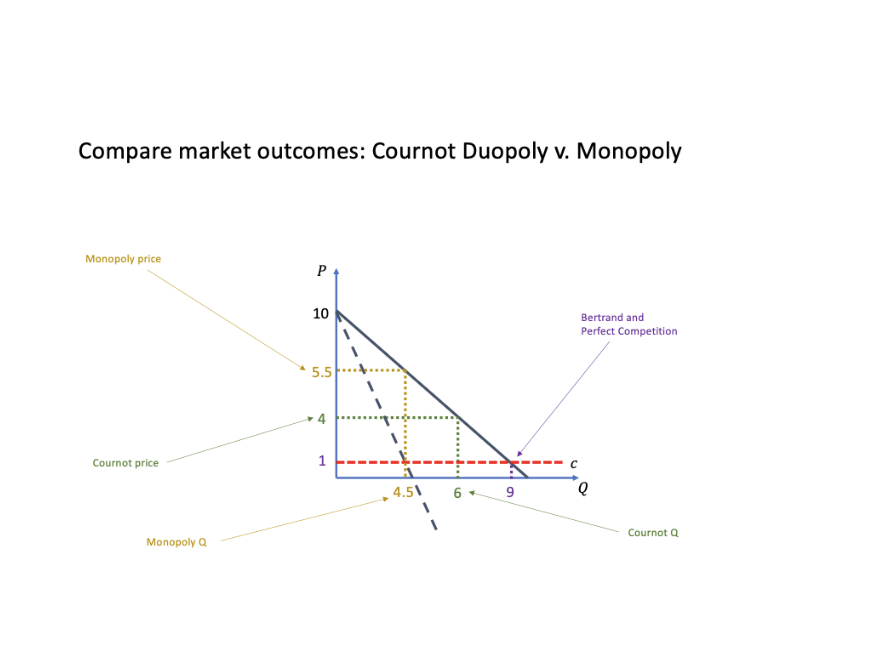
Types of Collusion
Explicit/Price Fixing-per se illegal
Tacit Collusion-no explicit agreement but choose high prices because all benefit from them
Price Fixing
Oligopoly prices are lower than monopoly prices
Can act like two halves of a monopolist
Incentive to cheat though
More likely when there are fewer compeitors and are of similar size/costs
1990s Vitamin Cartel
• Major US/Euro/Japanese producers agreed to fix prices across dozens of
vitamin classes (C, E, B9, H, B5, etc. )
• Communication: Between bi-weekly and bi-yearly telephone or in-person
meetings to exchange information.
• Monitoring: Gather prices on cartel members by talking to buyers.
• Threats to the cartels
• Increased supply from the “competitive fringe” (mainly Chinese producers)
• Slow-down in demand growth.
• Mergers and re-alignments.
• Caught: ADM was being investigates for another cartel (Lysine) and
cooperated with the DOJ to provide info on the Vitamin cartels.
Railroads in the 1880s
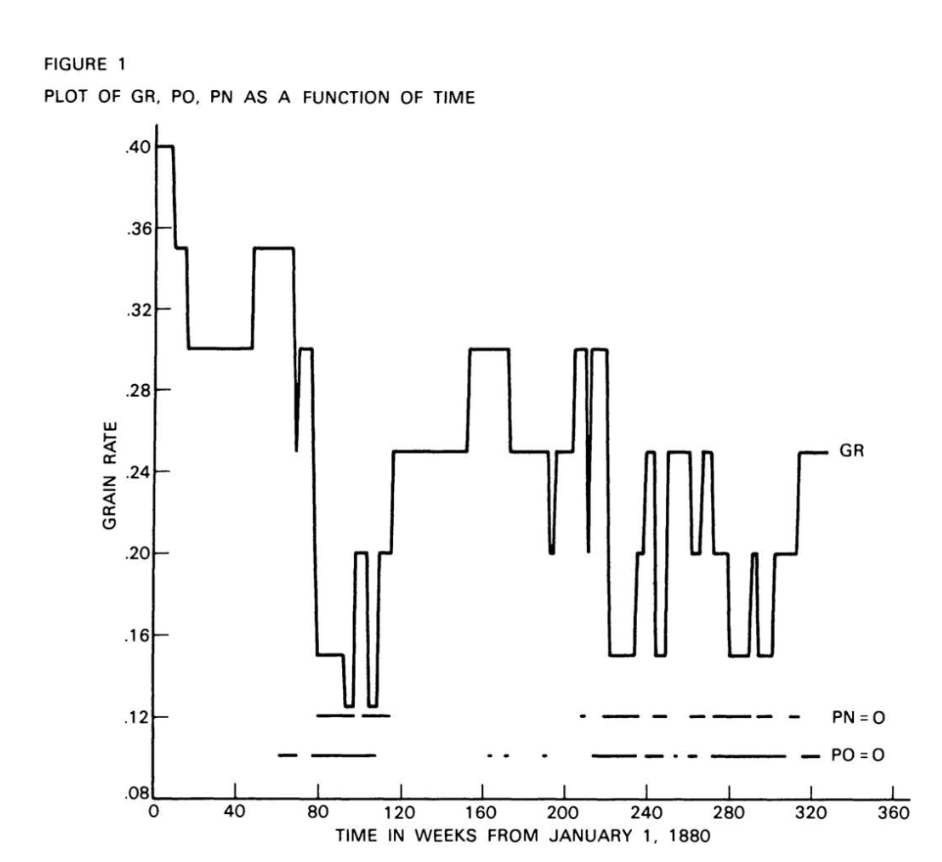
Cartels
messy and hard to explain all price movement with simple theories
Tacit Collusion
avoids Bertrand result
• Two sellers sell the same product.
• Simultaneously announce the price.
• Lowest price product receives all of the demand.
• Same marginal cost (for now).
(so far, same as Bertrand)
But time is divided into a series of periods (example, days) and the
sellers play this same game every day.
Index time by
Grm Trigger Strategy
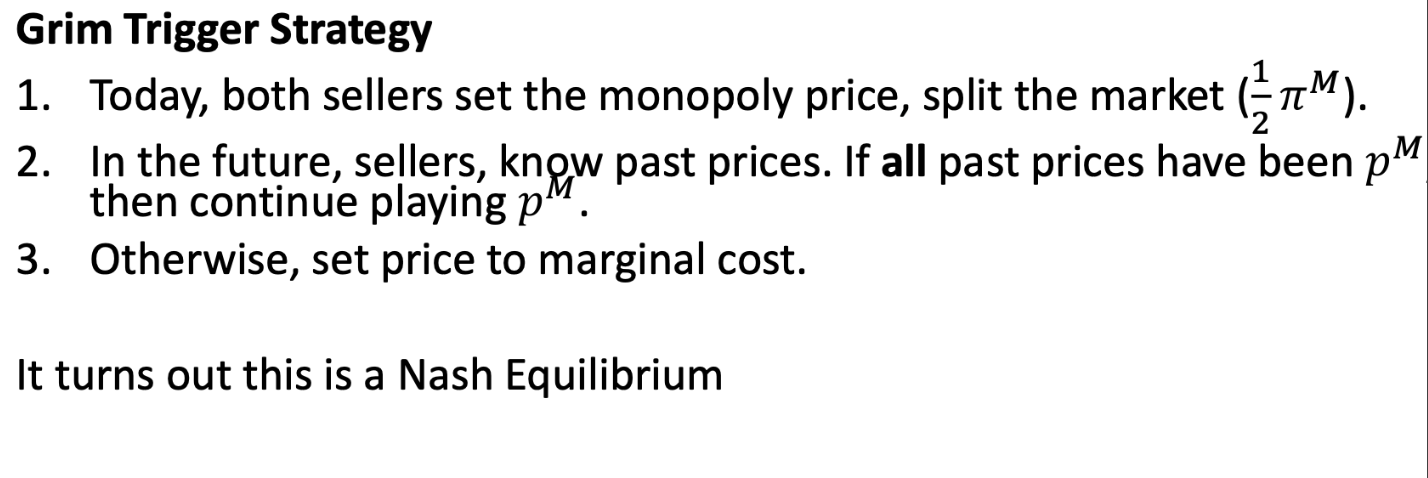
Grim Trigger part 2
Now the sellers care more about just today’s profit.
• There is a lot more at stake.
• They have more “tools” to choose from. [Larger strategy space.]
• They can “monitor” each other. [History of prices.]
![<p>Now the sellers care more about just today’s profit.<br>• There is a lot more at stake.<br>• They have more “tools” to choose from. [Larger strategy space.]<br>• They can “monitor” each other. [History of prices.]</p>](https://knowt-user-attachments.s3.amazonaws.com/2bc37973-4596-45be-a447-34f560a3b161.jpeg)

Value of $1 tomorrow
f=period
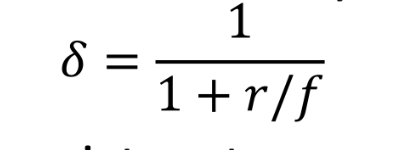
What if another seller enters? What if demand/profits grow?

So what effects if we collude?
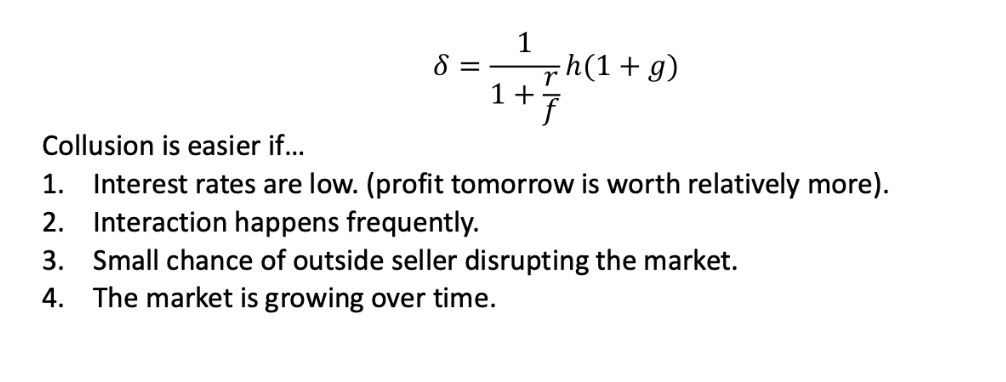
Restraints of Trade
Pillar 1
Prohibits agreements that are unreasonablt harmful to comp
Horizontal agreement
Vertical Agreement
Other Agreements
1. Horizontal agreements between actual or potential competitors. The most likely
kind of agreement to raise competitive concerns.
2. Vertical agreements between parties at different levels of the supply chain (or
suppliers of complements). Often untroubling; but can raise concerns.
3. Other agreements between parties that are in neither a horizontal nor a vertical
relationship. Virtually never troubling under modern law.
Per se
a few horizontal agreements-nakely anticompetitve
Rule of reason
all vertical and most horizontal
Quick Look
In between-its a quick look
What types of agreements are exempt?
Not economically independent
a. Employees of the same company.
b. Business partners in a partnership.
c. Stores of the same chain.
d. Divisions of the same corporation.
Copperweld (1984)
1. Before 1984: a corporation could
be liable for conspiracy with its
own wholly-owned subsidiary.
2. Copperweld involved an
allegation that Copperweld was
conspiring with its own sub to
injure a rival.
3. Court held: a corporation and
wholly owned subsidiary are
not sufficiently separate to
“conspire” in violation of §1.
—UNITY OF INTERST IS KEY-team of horses controlled by single driver
Examples of wholly-owned subsidiaries:
• Alphabet wholly owns Google
• Apple wholly owns Beats
• Warner Bros wholly owns HBO
• Sony wholly owns Sony Interactive Entertainment
Examples of wholly-owned subsidiaries:
• Alphabet wholly owns Google
• Apple wholly owns Beats
• Warner Bros wholly owns HBO
• Sony wholly owns Sony Interactive EntertainmentParent company
Parent companyWholly-owned subsidiary
Wholly-owned subsidiary
What counts as single entity
Parent and wholly owned subsidiary, grandparent and wholly owned subsidary of wholly owned subsidiary, sibling wholly owned subsidiaries
Does Copperweld mean that anything involving complete ownership is immune from antitrust scrutiny?
No!
1. “A corporation’s initial acquisition of
control will always be subject to
scrutiny under Section 1 of the
Sherman Act and Section 7 of the
Clayton Act.”
2. And the conduct of the unitary firm
may be subject to Section 2 if a
monopolist (and Section 1 if it enters
agreements w others!).
3. Just can’t “collude” with each other.
American Needle Inc v NFL
National Football League Properties
(“NFLP”)
1. Created by 32 teams to jointly market IP
2. IP owned by individual teams
3. Teams free to withdraw at any time
NFLP gave exclusive license to Reebok to
make and sell headwear for all teams
American Needle sued under § 1
Key issue:
When NFLP acts, is it unilateral action or
joint conduct?
“The key is whether the [alleged
agreement] ... joins together
separate decisionmakers”
Is it an agreement “amongst
separate economic actors
pursuing separate economic
interests . . . that . . . deprives the
marketplace of independent
centers of decisionmaking.”
IT IS SUBJECT TO SECTION 1
Why?
1. “[S]eparately controlled potential
competitors with [distinct] economic
interests.”
2. Behavior driven by each team’s
own economic interest – which may
diverge or conflict.
3. Profit / loss sharing is relevant but
can’t be dispositive. (Why not?)
Legal person and antitrust
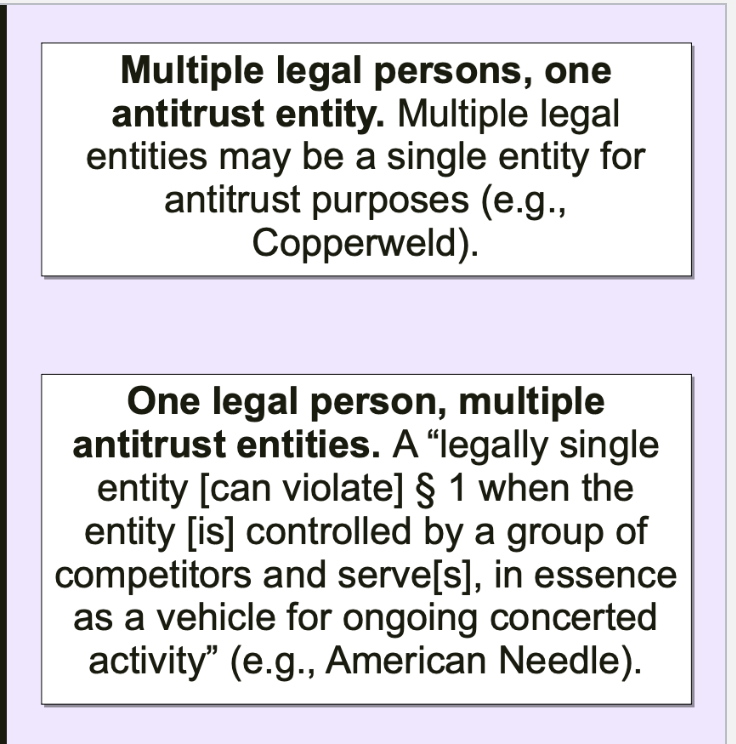
Monsanto Co v Spray-Rite Corp
1. Monsanto made herbicides
Small market share (3-15%)
2. Spray-Rite was a distributor for
Monsanto
90% of its sales were herbicides, but
only 16% of sales were Monsanto
3. Monsanto did not renew Spray-
Rite’s distributorship.
4. Spray-Rite sued!
Alleged that it was terminated as part
of a “resale price maintenance”
conspiracy between Monsanto and
other distributors.
USES THE RULE OF REASON—Supreme Court Affirm judgement that it is a violation but not for same reasons
Courts Test for was there an agreement:
t means as well that
evidence must be presented both that
the distributor communicated its
acquiescence or agreement, and that
this was sought by the manufacturer.”
2. “[T]here must be evidence that tends to
exclude the possibility of independent
action by the manufacturer and
distributor. That is, there must be direct or
circumstantial evidence that reasonably
tends to prove that the manufacturer and
others had a conscious commitment to
a common scheme.”8
Matsushita Electric Indusrtial Company v Zenith Radio Corp
. 21 Japanese TV companies
allegedly agreed to:
1. collectively raise prices in Japan; and
2. lower them in the United States...
3. ...to drive US firms out of business!
2. The Japanese companies then
would raise price in U.S. and make
monopoly profits!
What kind of antitrust claim is this?
Conspiracy to engage in collective
predatory pricing
Challenged under Sections 1 and 2
Very unusual theory!
Court didn’t buy accusations of preditory pricing
1. A 21-firm conspiracy over 20 years?
a. Hard to sustain, easy to cheat
b. Must endure losses for two decades
2. Difficulty in recoupment
a. Nowhere near monopoly after 20 yrs!
b. Scheme will fail if firms cheat or enter
3. Supracompetitive profits in Japan don’t
change the calculus
a. Doesn’t make low prices more profitable in
the United States
b. Evidence of a cartel in Japan doesn’t prove
predation in the United States
4. And proving agreement on minimum US
prices doesn’t imply predation.
Take aways:
1. Less plausible theories of harm may
require more evidence to survive
summary judgment.
A “sliding scale”?
2. Evidence must “tend to exclude”
independent action.
If conduct is equally consistent with no
conspiracy, it does not help the
plaintiff’s case at all. See Monsanto.
Dissent: the Court is invading the
factfinder’s province!
Preditory Pricing
Two key legal elements:
1. Pricing below the defendant’s
own costs; and
2. Dangerous probability of
recoupment of profits through
increased monopoly power after
the predation.
Bell Atlantic v Twombly
1. Breakup. When AT&T was broken up by consent decree in the 80s, it created many
local telephone monopolies (“Incumbent Local Exchange Carriers”; “ILECs”).
2. Competition? In the Telecommunications Act of 1996, the local monopolies were
withdrawn. New obligations were created (e.g., forced sharing, unbundling, etc.) to
encourage competitive entry by Competitive LECs (“CLECs”).
3. Competition, anyone? But it didn’t really happen!
So Twombly sued, alleging two agreements:
1. ILECs agreed to exclude competitive entry (CLECs) from their own markets.
2. ILECs agreed not to enter one another’s markets.
The ILECs moved to dismiss the complaint under Rule 12(b)(6) for failure to state a claim.
Complaint under Rule 8:
Must contain “a short and plain
statement of the claim showing the
pleader is entitled to relief.”
Must “give the defendant fair notice of
what the ... claim is and the grounds
upon which it rests.”
Dismissal under Rule 12(b)(6) for
failure to state a claim:
Before Twombly, the Conley v.
Gibson test (1957) governed: dismiss
a complaint only if “plaintiff can prove
no set of facts” entitling it to relief.
This was a generous standard
Complaint dismissed
1. Exclusion was rational for each ILEC individually: can’t infer agreement.
2. Not starting a competitive war was also rational: can’t infer agreement.
• “The ILECs were born in [a noncompetitive world], doubtless liked the world the way it was,
and surely knew the adage about him who lives by the sword. Hence, a natural explanation
for the noncompetition alleged is that the former Government-sanctioned monopolists were
sitting tight, expecting their neighbors to do the same thing.”
Ruled that you need plus factors to make decision!!!
A plaintiff needs “a complaint with
enough factual matter (taken as
true) to suggest that an agreement
was made. Asking for plausible
grounds to infer an agreement does
not impose a probability requirement
at the pleading stage; it simply calls
for enough fact to raise a
reasonable expectation that
discovery will reveal evidence of
illegal agreement
In Re Text Messaging
Judge Posner refused to dismiss a
complaint alleging price-fixing of SMS
messages.
Allegations:
1. Four providers with 90% share.
2. Exchanged price information in trade
ass’n “leadership” group.
3. Costs fell but prices rose.
4. Sudden uniform change in pricing:
new structure + 1/3 price increase.
5. Identical post-increase price (10c).
33
1. “[A] complaint must establish a
nonnegligible probability that the
claim is valid; but the probability need
not be as great as . . .
‘preponderance of the evidence.’”
2. “[C]omplex and historically
unprecedented changes in pricing
structure made at the very same time
by multiple competitors, . . . for no
other discernible reason . . . support
a plausible inference of conspiracy.”34
After Judge Posner’s, decision, the
case went back to the trial court for
discovery.
1. After discovery, defendants moved
for summary judgment
2. Trial court granted it
3. Back to Judge Posner...
4. ...who then affirmed SJ for
defendants.
1. Emails won’t do it.
1. Doesn’t speak to collusion. “Nothing in any of Hurditch’s emails suggests that he believed
there was a conspiracy among the carriers. There isn’t even evidence that he had ever
communicated on any subject with any employee of any of the other defendants.”
2. Efforts to delete. “The plaintiffs make much of the fact that Hurditch asked Roddy to delete
several emails in the chain that culminated in the “colusive” email. But that is consistent with his
not wanting to be detected by his superiors criticizing their management of the company.”
2. Pricing evidence wasn’t conclusive. Price increases accompanied surging
demand and were not in perfect lockstep.
3. Trade association doesn’t fill the gap. No evidence of unlawful agreement, and
no suspicious timing of price increases after meetings.
Some definitional hallmarks of “agreement”:
1. Evidence that acquiescence was sought and given (Monsanto)
2. Conscious commitment to a common scheme, even if not explicit / express (Monsanto)
3. MORE than:
1. mere knowing interdependent action (Twombly, Matsushita)
2. mere stating of conditions and policies (Monsanto)
Huge policy issue in the background:
• How could we workably prohibit tacit collusion? What is a company in a concentrated market
supposed to do? What would a remedy look like?
• What line can we draw that (a) is sensible, (b) doesn’t prohibit / punish too broadly, and (c) attaches at
a definable point that goes beyond mere parallelism?
Proving agreement:
1. Direct evidence of the agreement itself (e.g., emails describing it, testimony saying “we all agreed”)
2. Evidence of behavior that suggests an agreement (parallelism + “plus factors” like commc’ns)
trans-missouri freight
railroad price fixing
-majority held all restraints of trade illegal
Justice White’s dissent-argued for reasonableness standard
Addyston Pipe
Iron pipe cartel: was it a defense
that prices were set reasonably, to
avoid ruinous competition?
2. Judge Taft’s distinction:
1. Restraints “where the sole
object ... is merely to restrain
competition, and enhance or
maintain prices” are always
unlawful.
Today we say “naked” restraints.
2. “Ancillary” restraints are OK if
reasonably necessary to the
accomplishment of a main, lawful
purpose (e.g., noncompete upon
sale of a business)
Create rule of reason style test for ancillary restraints
United States v Trenton Potteries
Cartel of sanitary pottery makers
Defendants argue that their fixed prices were reasonable
Determine all price-fixing agreements to be unreasonable
Effect can be inferred by the nature alone-
Rules of Reason Steps
1) Plaintiff must show prima facie harm (anti competitive effect)
2) Defendant must show benefit (“Procompetitive justification”)
3) Plaintiff must show restraing should be condemned-either unecessary for benefit or harms exceed benefits
United States v National Society of Professional Engineers
Ethical canon-argued that no price quotes until after hiring engirnner ensured product safety
Court held that is not a perimitted justification under rule of reason—-public saefty and ethics are NOT cognizable benefits
Favor competition
NCAA v Alston
District Court (affirmed by 9th)
1) Imposed liability for NCAA rules limiting education related benefits for student athletes
2) DId not condemn rules limiting scholarships and pau related to athletic performance
NCAA appealed
Step 1) Anticompetitive effect: NCAA had power to set wages
Monopsony power in a labor
market
Exercised that power with clear
anticompetitive effects
Compensation and benefits
lower as a result
NCAA didn’t meaningfully
dispute this
Step 2) Procompetitive Rationale
NCAA claim they needed to protect amateurism (offer not clear definition of this, no evidence it had effects on consumer demand, but rules preventing inlimited payments unrelated to education might play role in differentiating the NCAA
Step 3) Plaintiff’s Ultimate Burden
restrictions on education-related benefits far greater than needed (consumers didn’t care)—-not required to be the least restrictive alternative though
Kavanugh’s concurrence:
1) Rule of reason
2) Price-fixing labor is price fixing labor
3) Supressing pay of students when they get biollions for colleges-and students who generate it get nothing
4) Tradition is not enough
Quick Look
1. Between per se illegality and the “full” rule of reason!
2. Plaintiff’s prima facie burden is discharged by the nature and context of an
agreement when the threat to competition is clear.
1. No need to show actual effects!
2. Somewhat like “indirect evidence” at step one of normal rule of reason?
3. Defendant has an opportunity to show that there are serious procompetitive
benefits; if so, burden flips back to plaintiff for fuller showing.
NCAA v Board of Regents of the University of Oklahoma
Quick look
NCAA’s plan:
1. Coordinated limitation on TV deals
2. Price coordination (fixed aggregate and
“recommended” payments)
3. Clear restriction on TV output
4. Purportedly intended to avoid
cannibalizing demand for live games
Legal proceedings:
5. Some schools sued the NCAA
6. Went to trial in district court
7. Trial court found a Section 1 violation
8. Court of appeals affirmed: illegal per se
Supreme Court found that it should not be a per se case!
1) Horizontal restraints are essential in some capacity for its existence
2) The intergrity of the product cannot be preserved except by mutal agreement
3) Respondents conceded that the great majority of regulations inhance competition
But this practice also was not okay!
1) Broader record made it clear it was harmful-price is higher and output lower than would otherwise be and both are unresponsive to consumer preference
2) So NCAA has a heavy burden of establishing an affirmative densene which compeititvely justifies the apparent deviation
Defendant’s justifications-this was just efficiency-enhancing
Coiurt reply-Price increased and quantity decreased
Also argue protect live audience-but no suporting evidence
Per se vs Rule of Reasons
Effects of a per se rule:
1. Easy to administer?
2. Cheaper to litigate?
Unless the bounds of the rule are unclear!
3. But overbroad rules chill competition!
Effects of a rule of reason?
4. More likely to get to the right result?
If we trust judicial accuracy in individual
cases!
5. More expensive to administer and
litigate?
6. Long expensive lawsuits...
...may discourage meritorious suits
...may allow plaintiffs to hold up defendants
with meritless claims
43
Wollman Paper
DOES ENTRY REMEDY COLLUSION?
EVIDENCE FROM THE GENERIC
PRESCRIPTION DRUG CARTEL
Branded drug loses exclusivity → ANDAs → generic entry
• Typically heralded as competition success story
(>50% market share at >50% lower prices [Scott Morton, 1999])
• Average prices in the 2010s increased substantially
Lawsuit: US States vs. Teva et. al. (May 20, 2019)
• List of cartelized drugs
• Date each cartel is formed
• For background, NP’s selection rule (e.g., quality ratings of rivals),
phone records, relevant emails and texts
• To check data, Teva’s breakdown of market share by drug-firm
• FDA: ANDA filings, approvals, and entry dates
• Medicaid: Price and quantity
• IQVIA: Scales Medicaid, alt. quantity measure
Drug-firm-quarter or drug-firm-year
Assume cartels play trigger strategy
PI File—-number of firms and how close they are
Data-list of cartelized drugs, dta formed, Nisha Patel’s selection rule
Large drug market definition-above vs below the median
Maternity leave-9 month period where no cartel formation
FDA response-less likely but medicare and other things really care
“most favored nation”-should get at least price of lowest nation